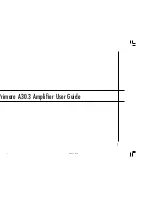
PS Cabinet
Tips & Troubleshooting
13
PS cabinets are equipped with Combo Neutrik Connectors. This means that you can
use a Speakon connector or a ¼” connector. How? In the center of the Speakon
connector you’ll find ¼” hole to insert a ¼” jack. For higher-power handling and more
secure connections, use Speakon-to-Speakon cables with a speaker wire of at least
16-gauge. A lower gauge number means thicker cabling, so a 14-gauge cable is
thicker in diameter and thus better than a 16-gauge cable. Thicker cabling means
better low-frequency transmission to the cabinets.
Pin connection inside the Speakon connector should be +1 and -1. Be sure to spec-
ify this configuration when buying your speaker cables. Although this is the most
common style, it is not the only style made.
The Input/Output connections in the back of your cabinets are wired in parallel. If you
daisy chain two 8-ohm cabinets, you will have a total impedance of 4 ohms. If your
amp minimum load is 4 ohms, it means that you can use two 8-ohm cabinets or a
single 4-ohm cabinet. In the PS1000, we have two 500-watt @4-ohm amplifiers. You
can use as many as a pair of 4x10 8 ohms cabinets for each of the amplifiers, for a
total of four 8-ohm cabinets. That would be four 4x10’s for a total of 16 10-inch
drivers. That’s enough sound to drive an arena! You could also drive a pair of 4-ohm
cabinets, one on each amplifier. In either event, be sure to wear proper ear
protection - the PS amplifiers are very loud, high-fidelity amplifiers. We want you to
have a very long and enjoyable music career, so please protect your ears when
performing at high volumes.
When using multiple cabinets, be sure they are all in “phase”. With a 9V battery (the
same battery used inside most active basses) you can test the polarity, or phase, of
your speakers to make sure all are working and moving in the right direction –
forward! Sometimes, when you daisy chain two cabinets, you will note a lack of bass
response. Typically, this means that one of the cabinets is out of phase and its
speakers are moving backward when they should be moving forward. If one cabinet
or one speaker is moving backwards when the other moves forward, they will cancel
each other out. You can readily notice this when a single cabinet has more bass and
better response then when two are connected. Here’s how to verify phase. Take a ¼”
cable. Insert one side into a cabinet and touch the other tip of the ¼” jack to the “+”
of a 9-volt battery and the shaft to the “-” of the battery. The connected speaker
should move forward when this connection is made. If it does, the cabinet is in
phase. If it moves backwards, you have a cabinet that’s wired out of phase. The
problem can be easily corrected by a speaker technician.
All manuals and user guides at all-guides.com


































